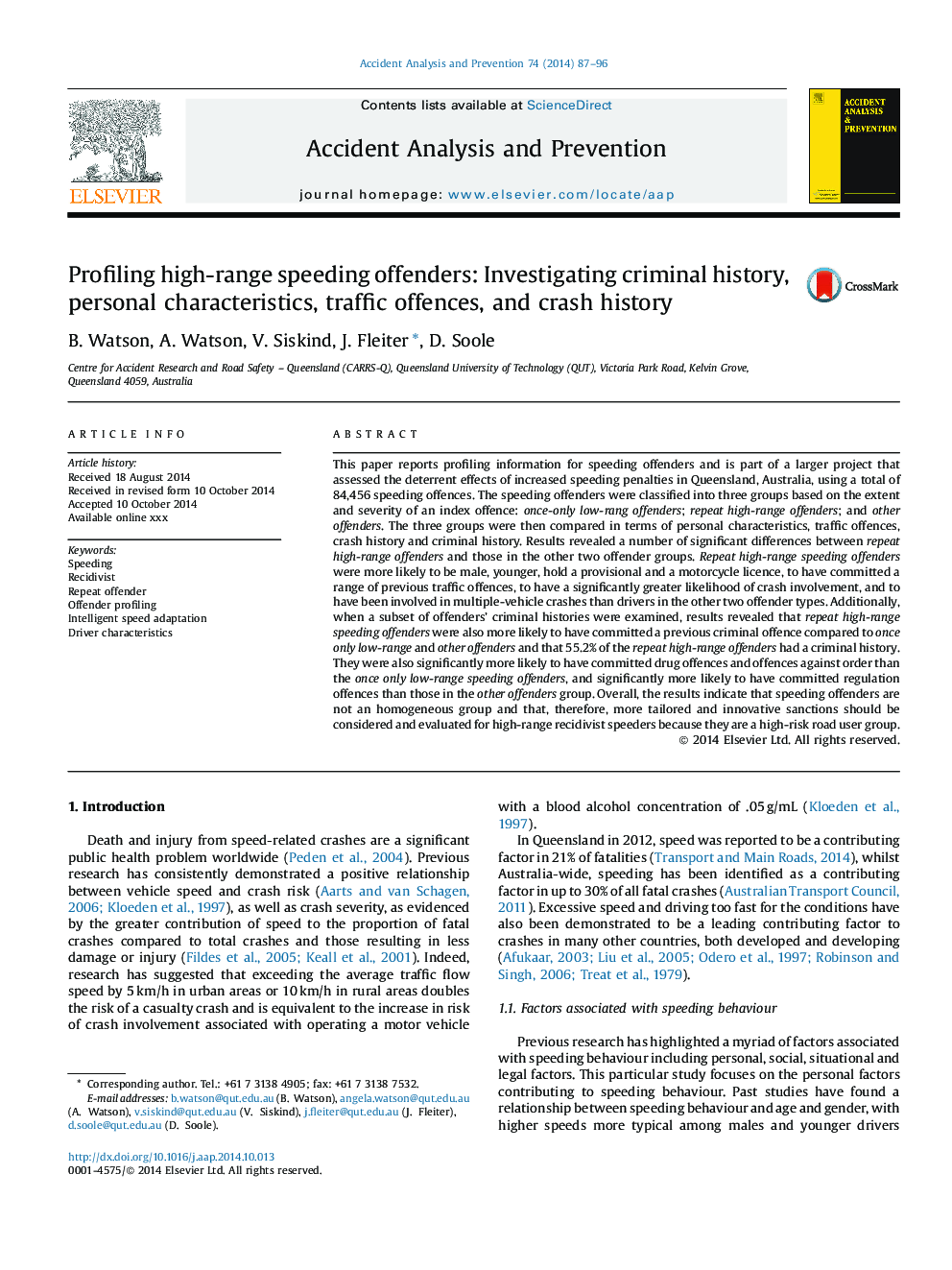| کد مقاله | کد نشریه | سال انتشار | مقاله انگلیسی | نسخه تمام متن |
|---|---|---|---|---|
| 6965779 | 1452923 | 2015 | 10 صفحه PDF | دانلود رایگان |
عنوان انگلیسی مقاله ISI
Profiling high-range speeding offenders: Investigating criminal history, personal characteristics, traffic offences, and crash history
ترجمه فارسی عنوان
سوءاستفاده از مجرمان با سرعت بالا: بررسی تاریخچه جنایی، خصوصیات شخصی، تخلفات جاده ای و تاریخ سقوط
دانلود مقاله + سفارش ترجمه
دانلود مقاله ISI انگلیسی
رایگان برای ایرانیان
کلمات کلیدی
سرعت بالا بازدارنده مجرمان را تکرار کنید نمایندگی مجرم سازگاری سرعت هوشمند، ویژگی های راننده
ترجمه چکیده
این مقاله اطلاعات اطلاعات را برای سرعت بخشیدن مجرمین گزارش می کند و بخشی از یک پروژه بزرگتر است که اثرات بازدارنده افزایش مجازات سرعت در کوئینزلند استرالیا را با استفاده از 84456 جرائم به سرعت افزایش می دهد. مجرمان سرعت بخشیدن به سه گروه به ترتیب به میزان و شدت یک جرم شاخص تقسیم شدند: یک مرتبه مجرمان کم شنوایی؛ تکرار مجرمان با محدوده وسیع؛ و سایر مجرمان سپس سه گروه از لحاظ مشخصات شخصی، تخلفات جاده ای، تاریخچه سقوط و تاریخ جنایی مورد مقایسه قرار گرفت. نتایج نشان داد تعدادی از تفاوت های قابل توجه بین مجرمان با تکرار بالا و کسانی که در دو گروه متخلف دیگر وجود دارد. تکرار مجرمان با سرعت بالا، بیشتر احتمال دارد که مرد باشد، جوانتر، مجوز موقت و موتور سیکلت داشته باشد، چندین تخلف از تخلفات مربوط به ترافیک را مرتکب شود، احتمال بیشتری برای تصادف وجود داشته باشد، و در چندین بار سقوط خودروها از رانندگان در دو نوع متخلف دیگر. علاوه بر این، هنگامی که یک زیر مجموعه از تاریخچه جنایات مجرمان مورد بررسی قرار گرفت، نتایج نشان داد که مجرمان با سرعت بالا مجددا تکرار می شد، بیشتر احتمال دارد مرتکب یک جرم جنایی قبلی در مقایسه با یک بار مجازات کم و دیگر مجرمان شده و 55.2٪ از تکرار مجرمین با دامنه وسیعی سابقه کیفری داشته اند. آنها همچنین به احتمال زیاد به جرایم مواد مخدر و جرایم علیه نظم نسبت به افرادی که مرتکب شده اند، سریعتر از حد مجاز هستند، و به احتمال زیاد مرتکب تخلفات مقرراتی نسبت به سایر گروه های مجرم می شوند. به طور کلی، نتایج نشان می دهد که متخلفان سرعت بخشیدن به یک گروه همگن نیستند و بنابراین، باید برای افرادی که در معرض ریسک بالا قرار دارند، تحریم های متناسب و متنوع تر مورد توجه و ارزیابی قرار می گیرند، زیرا آنها یک گروه کاربر جاده ای با ریسک بالا هستند.
موضوعات مرتبط
مهندسی و علوم پایه
مهندسی شیمی
بهداشت و امنیت شیمی
چکیده انگلیسی
This paper reports profiling information for speeding offenders and is part of a larger project that assessed the deterrent effects of increased speeding penalties in Queensland, Australia, using a total of 84,456 speeding offences. The speeding offenders were classified into three groups based on the extent and severity of an index offence: once-only low-rang offenders; repeat high-range offenders; and other offenders. The three groups were then compared in terms of personal characteristics, traffic offences, crash history and criminal history. Results revealed a number of significant differences between repeat high-range offenders and those in the other two offender groups. Repeat high-range speeding offenders were more likely to be male, younger, hold a provisional and a motorcycle licence, to have committed a range of previous traffic offences, to have a significantly greater likelihood of crash involvement, and to have been involved in multiple-vehicle crashes than drivers in the other two offender types. Additionally, when a subset of offenders' criminal histories were examined, results revealed that repeat high-range speeding offenders were also more likely to have committed a previous criminal offence compared to once only low-range and other offenders and that 55.2% of the repeat high-range offenders had a criminal history. They were also significantly more likely to have committed drug offences and offences against order than the once only low-range speeding offenders, and significantly more likely to have committed regulation offences than those in the other offenders group. Overall, the results indicate that speeding offenders are not an homogeneous group and that, therefore, more tailored and innovative sanctions should be considered and evaluated for high-range recidivist speeders because they are a high-risk road user group.
ناشر
Database: Elsevier - ScienceDirect (ساینس دایرکت)
Journal: Accident Analysis & Prevention - Volume 74, January 2015, Pages 87-96
Journal: Accident Analysis & Prevention - Volume 74, January 2015, Pages 87-96
نویسندگان
B. Watson, A. Watson, V. Siskind, J. Fleiter, D. Soole,
